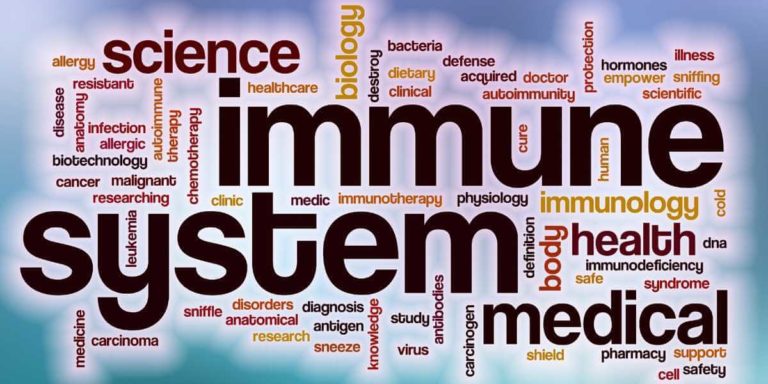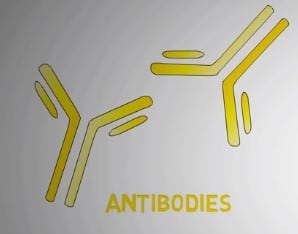Immune System | Learn Everything about Immune System

IMMUNE SYSTEM DEFINITION
The Immune system is the basic defence system of the body that protects us from harmful pathogens and diseases.
The immune system consists of various types of cells and different proteins that kill harmful micro-organisms and protect our body from disease.
In this article we will discuss the human Immune system, what is the basic structure of the human immune system, and how it functions?
Then we will also look at some of the factors which affect your immune system and the differences between the innate and acquired immunity
FUNCTION OF IMMUNE SYSTEM
The overall function of the immune system is to limit or prevent infection. When the immune system first recognizes invasion by pathogens, it responds to address the problem.
If an immune response cannot be activated when there is sufficient need, problems arise like infections and other diseases,
On the other hand, when the immune response is activated without the real threat or is not turned off once the danger passes, different problems arise such as allergic reactions and autoimmune diseases.
BASIC STRUCTURE OF IMMUNE SYSTEM
The immune system essentially consists of three layers of defence that protects our body from various types of attacks from micro-organisms and even non-living things like toxins, metals, etc.
Each layer consists of different mechanisms of immunity and when one layer is breached or invaded, the mechanisms of the layer below it come into action until the attack is successfully controlled.
The first basic layer of the Human immune system is the Barrier Immunity below which is the Innate Immunity and finally, we have the Acquired Immunity.
Let’s discuss the three layers of immunity in details
BARRIER IMMUNITY
The first layer of the Immune system is the Barrier immunity and the most important part of it is “THE SKIN”
Skin is considered as the largest organ of the Human body with an average surface area of 1.73m2. In simple terms, physical barriers prevent pathogens such as viruses and bacteria from entering the organism.
The skin not only provides a Physical barrier, that prevents any pathogens from entering our body but it also protects through chemical and biological barriers.
Skin cells produce and secrete important Antimicrobial proteins that kill the invading micro-organisms. The skin also contains immune cells that help to stop the microbes from invading our bodies.
Shedding of skin epithelium also known as DESQUAMATION helps to remove bacteria and other infectious agents that may have adhered to the skin surface.
A similar type of Barrier Immunity also provided by many other surfaces present inside a body. Including the surface lining of our Respiratory System, the Gastrointestinal system, the Genitourinary System, and the surface lining of our nose and Pharynx.
All these types of surfaces provide a physical barrier that prevents the attack from pathogens, and they also provide various types of chemical anti-microbial, which try to stop the invading pathogens at a very early stage.
For example, the surface lining of our Respiratory System has the small hair projections that are known as Respiratory CILIA.
A special property of these cilia is that they have a particular direction of movement by virtue of which they remove any foreign material that may have entered our lungs while breathing.
This provides a strong physical barrier that prevents the build-up of micro-organisms and other foreign material in our lungs.
Defects in the function of CILIA are very common in smokers. This leads to higher incidents of chest infections.
The respiratory surface also provides various types of Anti-microbial chemicals like surfactants, mucus, and defensins which help to stop the invading micro-organisms.
Our stomach releases strong acids with a very low pH that kills most of the micro-organisms which we accidentally ingest while eating.
The tears in our eyes also contain special anti-microbial proteins like lysozyme, which kill many pathogens.
The constant flushing of tears also prevents any build-up of any foreign material in our eyes, which is also an example of Barrier Immunity.
What happens when a micro-organism say a bacteria or a virus evades our barrier immunity and is successful in entering in our body?
In that case, the micro-organism is met by our next layer of immune system that is known as the INNATE IMMUNITY
INNATE IMMUNITY
The name Innate is made up of two words IN and NATE. IN means inside and NATE means born.
So innate is something that you are born with. This immunity is present in our body from the time we were born. This is in comparison to the third layer of immunity that is acquired immunity that develops after we were born.
The Innate immune system is an older evolutionary defence strategy as compared to the Acquired Immunity that developed later.
Innate immunity is non-specific. Meaning, it does not have a special mechanism of action for a different type of pathogens.
The defence system of the innate immunity consists of the various types of cells and their complement system
VARIOUS CELLS OF INNATE IMMUNE SYSTEM
The different types of cells in our innate immune system are Neutrophils, Mast Cells, basophils, dendritic cells, Eosinophil, Monocytes, Macrophage, Natural Killer cells or NK Cells.
All these cells are types of White Blood Cells or WBCs also known as Leukocytes. Leuko meaning White and Cytes meaning Cells.
NEUTROPHILS
The NEUTROPHILS are the most abundant immune cells, making up about 60-70% of the total population of immune cells. They form an essential part of the innate immune system.
One word you will hear a lot in this Immune system is the word PHAGOCYTOSIS, Phago means eating and Cytosis means by a cell. So Phagocytosis in simple terms is cell eating.
Neutrophils are a type of Phagocytes that detect and eat the pathogen within the cell.
Within the cell, the neutrophils release various enzymes that kill and digest the pathogen. They are normally found in the bloodstream and are short-lived and highly mobile as they can enter parts of tissue where other cells or molecules cannot.
Neutrophils are usually the first cells to respond to any infection or inflammation.
This is due to their heightened ability to sense what’s going around the body by detecting special chemical signals released by pathogens and by our body cells that tell them what is going around in the body.
Neutrophils have some characteristic features. The first thing you would notice is the MULTI-LOBED NUCLEUS of the cell.
This is the normal appearance of the nucleus and this is the reason why neutrophils are also known as POLY-MORPHO-NUCLEAR-LEUKOCYTES.
Poly Morpho Nuclear meaning the nucleus of the cell has multiple morphologies meaning some neutrophils have 2 lobes in their nucleus, some 3 or 4 or 5. So there are multiple morphologies,
The nucleus of these neutrophils can have. So they are known as Poly-Morpho-Nuclear-Leukocytes.
Another characteristic feature you would notice in the structure of these cells is the presence of a large number of granules in the Cytoplasm.
On average, about 200-250 granules are present in each neutrophil and these granules contain many different types of enzymes and chemicals that have several functions in our immune system.
The Neutrophils release enzymes like MYELOPEROXIDASE, DEFENSINS, SERINE PROTEASES and various CYTOKINES that have numerous functions in our immune system.
They also release several other chemicals like alkaline phosphatase, NADPH oxidase, lysozyme that help in eliminating these pathogens.
As mentioned earlier, they are Phagocytic cells that detect and eat pathogens like bacteria. Upon ingesting the bacteria, the bacteria are contained in a bubble-like structure known as the PHAGOSOME.
This Phagosome gets fused with LYSOSOME. The granule of the cell which contains the Lysozyme in them which is a type of Enzyme.
The combination leads to the formation of a Phagolysosome. Very cellular enzymes kill the bacteria and digest it.
EOSINOPHILS
Eosinophils also have a similar looking nucleus to neutrophils, but it usually has only two lobes, hence named as GOGGLE SHAPED NUCLEUS.
They also contain numerous cellular granules that contain different types of chemicals and enzymes.
In normal individuals, Eosinophils make up about 1-3% of the white blood cells and are responsible for combating multicellular parasites and certain bacterial infections.
There are also some Eosinophils that play a vital role in fighting infections.
When unchecked, Eosinophils are responsible for tissue damage and inflammation in many diseases including asthma.
BASOPHILS
Basophils are the least common of the WBCs representing about 0.5-1% of the circulating white blood cells.
Basophils have a very important role in fighting the parasitic infections of the body in addition to fighting parasitic infections, Basophils play our role in preventing blood clotting as basophils contain HEPARIN.
They are also implicated in various allergic reactions.
MAST CELLS
Mast cells are a type of innate immune cells that reside in the connective tissue and the mucous membranes like the lining of our respiratory and gastrointestinal system.
Mast cells are associated with wound healing and defence against pathogens but are often associated with allergy and anaphylaxis which has serious allergic reactions that can cause death.
Mast cells also have numerous granules in them that contain abundant quantities of HISTAMINE AND HEPARIN.
Histamine dilates blood vessels which produce the characteristic signs of inflammation and recruits neutrophils and macrophages. They also help to link the Innate and Acquired immunity to fight against pathogens.
MACROPHAGE
Macrophage from the Greek meaning Large eaters are large phagocytic leukocytes, which are able to move outside of the vascular system by migrating across the walls of blood vessels and entering the areas between the cells in pursuit of invading pathogens.
MONOCYTES
These are the similar types of cells circulating in the blood. The word Monocyte means cell with one lobe nucleus.
The adhering of bacterial molecules to the receptors on the surface of a macrophage triggers it to engulf and destroy bacteria through the generation of reactive oxygen species.
Pathogens also stimulate the macrophage to produce CHEMOKINES, which are special chemicals that attract other immune cells to the site of infection.
DENDRITIC CELL
The word dendrite means branches and these cells are known as dendritic cells because they have branch-like projections from these cells.
Dendritic cells are found in those tissues that are in contact with the external environment such as the skin and the inner lining of the nose, lungs, stomach, and intestines.
The dendritic cells are a type of antigen-presenting cell that detects the pathogens and they take the antigens that are present on the surface of these pathogens to Lymphocytes.
LYMPHOCYTES are cells of Acquired immunity (or Adaptive immunity) that we will discuss later in this article.
The dendritic cells present these antigens to the Lymphocytes and this leads to attack on the Pathogens by these Lymphocytes and the antibodies they produce.
So they are known as the antigen-presenting cells as they present the antigen to the lymphocytes.
Dendritic cells are also known as the LANGERHANS CELLS after the scientist who discovered them.
Type 1 INTERFERONS secreted mainly is dendritic cells that play a central role in the body’s defence against viruses.
NATURAL KILLER CELLS (NK CELLS)
NK cells are the component of the innate immune system that does not directly attack the invading microbes, rather NK cells destroy our own cells that have become defective such as tumor cells or virus-infected cells.
So, these are various types of cells that are present in our innate immune system.
Apart from the physical and chemical barriers and various types of cells, the innate immune system also has a special type of defence mechanism system known as the COMPLEMENT SYSTEM.
COMPLEMENT SYSTEM
The complement system is a set of about 20 proteins and it is known as the complement system as it complements the action of the antibodies and other cells in destroying the pathogens,
Meaning the complement system helps the antibodies and other immune cells to destroy the invading microbes.
Many species have complement systems including non-mammals like plants, fishes and some invertebrates too. The basic mechanism of action of the complement system is as follows
Whenever any pathogen enters a body, it gets recognized by antibodies present in our blood. The binding of antibodies to the pathogens is the most important factor for the activation of the complement system.
After it is activated a cascade of different enzymes acts on the surface of the microbe to kill it. The complement system has many different mechanisms of action.
We will discuss more about the Complement system in some other article.
So, this is all about INNATE IMMUNE SYSTEM, the type of immunity that is present since birth. It is non-specific and comparatively weaker as compared to our third line of defence that is ACQUIRED IMMUNITY OR ADAPTIVE IMMUNITY.
ADAPTIVE IMMUNITY
The adaptive immune system is also known as Acquired immune system or more rarely the specific immune system is composed of highly specialized systemic cells and processes that eliminate the pathogens or prevent their growth.
Adaptive immunity is not present since birth and it is created in response to exposure to a foreign substance that is why the name adaptive immunity as it adapts according to the type of threat that we are exposed to.
MODEL OF WORKING OF ADAPTIVE IMMUNITY
When a pathogen invades our first and second line of defence, it is met by the adaptive immunity which mainly consists of lymphocytes and the antibodies they produce.
When a particular pathogen enters our body for the first time, the response of the adaptive immunity is minimal as it doesn’t recognize this pathogen yet. It remembers his exposure to the pathogen and stores an immunological memory of this encounter.

So, if you draw the first response of the adaptive immune system on a graph, it would look something like this.
Upon subsequent exposure to the same pathogen, there is an amplified response of the adaptive immune system sending multiple types of lymphocytes and antibodies that are specific for that pathogen only. This helps in successfully eliminating the pathogen.
The system is highly adaptable because once encountered, the immunological memory of that pathogen remains in our system forever and upon subsequent invasion by the same pathogen, a full mounted defence system is already present in our body.
The cells of the Acquired immune system are the T LYMPHOCYTES and the B LYMPHOCYTES.
Lymphocytes are a subset of leukocytes, meaning they are also a type of White Blood Cells.
B cells and T cells are the major types of lymphocytes. The human body has about 2 Trillian lymphocytes constituting 20-40% of the WBCs.
Their total mass is about the same as a brain or a liver. The peripheral blood contains 2% circulating lymphocytes, the rest of them move within the tissue spaces and the lymphatic system.
The Adaptive immune system is divided into two main types. The HUMORAL IMMUNITY, which is due to the B Lymphocytes and the CELLULAR IMMUNITY, which is due to the T Lymphocytes.
The T lymphocytes are again divided into two major types. The HELPER T CELLS and the CYTOTOXIC or the KILLER T CELLS.
The cytotoxic or the cd8 T cells have a major role in killing the pathogens by directly interacting with the invading microbes. Whereas the Helper T cells or the cd4 T cells have an indirect but very important role in our immune system.
The helper T cells are responsible for the proper functioning of the rest of the immune cells including their close cousins, the cd8 cells.
They secrete a large number of growth factors and their cytokines that are essential for maturation of other types of immune cells.
One of the most deadly diseases of our century AIDS or Acquired Immunodeficiency Syndrome acts by killing our cd4 or the T helper cells only.
The number decreases so much that it cripples our whole immune system and our body gets overwhelmed by a lot of infections that do not usually occur in a normal healthy person.

The other major types of lymphocyte in our blood are the B lymphocytes which are responsible for Humoral Immunity.
The B-lymphocytes produce a special type of protein known as the “antibody” which looks something like this

As you can see, it is a y-shaped structure in which the terminal end of the protein is specially designed to recognize and capture antigens that are present on the surface of bacteria and other pathogens
This, of course, happens after the B Lymphocytes have had their first contact with the pathogen earlier, which led to an immunological memory stored inside these cells.
Upon subsequent encounter with the same pathogen by the B lymphocytes, the cells produce a large number of antigen-specific antibodies that recognize and capture the invading pathogen.
Now, the antibodies do not destroy these invading pathogens by themselves but activate a number of different mechanisms of our immune system including the complement system and the various types of phagocytic cells like Neutrophils.
One of the very important functions of these antibodies is known as the OPSONIZATION. This, in simple words just means sugar-coating a pill to make it tastier.
Now, what these antibodies do is that, when they recognize a particular pathogen, they attach to it and then completely coat it with lots of antibodies, this is known as OPSONIZATION.
The coated cell acts as a signal to other immune cells like the neutrophils which come and digest the coated cell, therefore the antibodies mark the pathogens so they can be destroyed by other immune cells.
DIFFERENCES BETWEEN THE INNATE AND ADAPTIVE IMMUNITY
- When we look at how each type of immunity develops, innate immunity is present since our birth while the adaptive immune system is a type of immunity that develops after we are born.
- Talking about specificity, the innate immunity is NON-SPECIFIC whereas, the adaptive immunity is very SPECIFIC.
{Innate immunity is non-specific as it doesn’t have any specialized defence systems for different types of pathogens, rather it uses a common defence system to kill all the types of pathogens and a single immune defence mechanism of innate immunity is able to defend against a wide variety of pathogens. This is in contrast to the SPECIFIC immune system that has special types of antibodies and cells that are specific and act only on the pathogens they recognize}.
- When we look at the time that each system takes to respond to an infection, the innate immune system has a very rapid response to any infection since this type of immunity is already present in our body while the adaptive immune system is slow to respond as it needs the first exposure to develop a memory of the pathogen.
- If we look at the potency of each system, the innate immune system is less potent as compared to adaptive immunity which just means that the adaptive immune system has more power to kill pathogens. Since of course it has cells and antibodies that are made specifically for that pathogen.
- One important difference between the innate and adaptive immune systems is that the innate type of immunity is generally inherited from parents and passed off to the offspring. While the adaptive immunity is not passed from the parents to the offspring, hence it cannot be inherited.
- If we look at the evolutionary basis, the innate immunity is older and is found in both vertebrates and invertebrates. While the adaptive immune system has been developed recently and is found only invertebrates.
- The various components of the innate immune system are physical and chemical barriers, Phagocytic leukocytes, dendritic cells, and natural killer cells. While, the adaptive immune system is composed of T cells, B cells and the antibodies they produce.
| INNATE IMMUNITY | ADAPTIVE IMMUNITY | |
| DEVELOPMENT | PRESENT SINCE BIRTH | DEVELOPS AFTER BIRTH |
| SPECIFICITY | NON-SPECIFIC | SPECIFIC |
| RESPONSE TIME | FAST | SLOW |
| POTENCY | LESS POTENT | MORE POTENT |
| INHERITANCE | INHERITED | NO INHERITANCE |
Some Frequently Asked Questions
How does Immune System Works?
What are the 5 parts of Immune system?
What are the 3 Types of Immunity?
What do you mean by Immunity?
What immunity lasts Lifetime?
What kind of immunity are People born with?
How many types of Immune cells are there?
This was all about Immune system, I hope you have now understood the in and out structure of our Immune system.
If you find this information useful, kindly share it with your friends.




